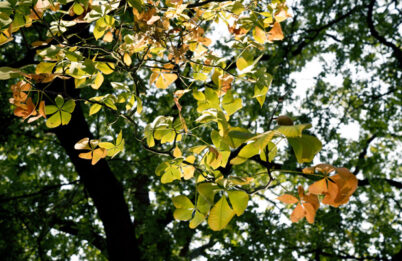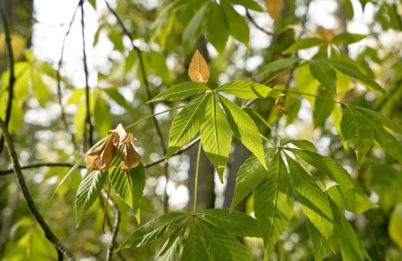Rote Roßkastanie (südöstliches Nordamerika)
Die in Nordamerika beheimatete Rote Rosskastanie wächst als Strauch oder Kleinbaum mit ovalrunder, locker geschlossener Krone, deren obere Äste etwas zum Überhängen neigen.
Auffällig groß sind die überwiegend fünf-, seltener bis zu siebenfingrigen Blätter mit länglich, eiförmig, schmal elliptisch, lanzettlich oder verkehrtlanzettlichen Fiederblättchen mit zugespitztem Blattende und -grund. Sie sind häutig bis leicht ledrig, stumpf bis leuchtend dunkelgrün mit rötlichen Mittel- und Seitenrippen, treiben rötlich aus und fallen früh im Herbst ohne sich nennenswert zu verfärben.
Ende Mai erscheinen längliche aufrechte Rispen mit lachsroten Blüten (A. pavia var. pavia). Die nur in Texas vorkommende Unterart Aesculus pavia var. flavescens hat gelbliche Blüten.
Im Herbst bilden sich annähernd kugelige bis eiförmige Kapselfrüchte mit glattem, leicht narbigem hellbraunen Perikarp. Die 1 bis 3 (selten 4 bis 6) dunkel-kastanienbraunen bis hell-gelbbraunen Samen haben einen hellen Nabel.
| Habitus | Strauch / Kleinbaum, ovalrunde Krone, locker geschlossen, oft mehrstämmig |
|---|---|
| Blatt | handförmig gefingert, 5-7 Fiederblättchen, länglich, eiförmig, schmal elliptisch, lanzettlich oder verkehrtlanzettlichen, Blattende und -grund zugespitzt, rötlicher Austrieb, keine Herbstfärbung |
| Blüte | längliche Rispen, lachsrote Blüten |
| Frucht | fachspaltige Kapselfrüchte, annähernd kugelig bis eiförmig; glattes, leicht narbiges hellbraunes Perikarp; 1 bis 3 (selten 4 bis 6) dunkel-kastanienbraune bis hell-gelbbraune Samen, heller Nabel |
| Standort | leicht feucht, keine harten Böden |
| Härtegrad | Zone 6b (-20,5 bis -17,8 °C) |
| Fauna | Bienen, Falter, kleine Säugetiere |
| Synonyme | Echte Pavie |




